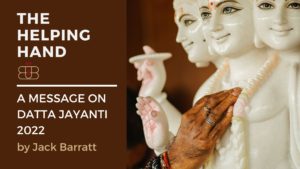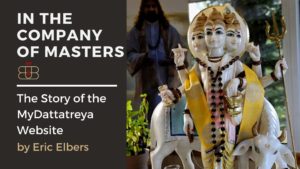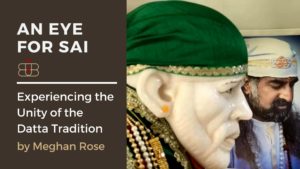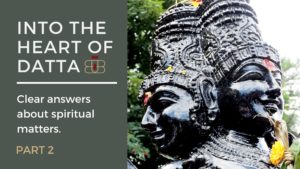Sri Nisargadatta Maharaj
Overview and Significance
Sri Nisargadatta Maharaj is a Master of devotional non-duality and the founder of Nisarga Yoga, which he taught to his students. Nisargadatta belongs to the Datta/Navnath Tradition of Masters, and observing that, he instructed his students not to follow any particular path. This is well in line with the teachings of current Datta Master Mohanji about a “pathless path” or white path as a way of total liberation and dissolution. He taught his students to stabilise in the beingness or what he called ‘I am-ness consciousness’ for beingness to reveal its ultimate Source – The Self.
Life History
Sri Nisargadatta Maharaj was born on April 17, 1897, at the break of dawn in Mumbai. He was the second eldest of six children born to his parents Shivrampant Kambli and Parvati Bai. Significantly, this is the same day on which the great Lord Hanuman was born, the monkey king, fearless and selfless helper of Lord Rama in the Rama era. Sri Nisargadatta Maharaj was named Maruti by his parents, which is one of the names of Lord Hanuman. Although he was born in Mumbai, he grew up in the small village Kandalgaon in the Sindhudurga district of Maharashtra, where his father worked as a small farmer. Both His parents were followers of the Varkari Sampradaya and egalitarian Vaishnavite bhakti tradition, which worships Vithoba. Sri Nisargadatta Maharaj was engaged in all types of manual labour at the farm. Although He didn’t have much formal education, he absorbed many spiritual teachings listening to conversations between His father and his friends.
In 1915, after his father died, he moved to Bombay to support his family back home, following his elder brother. Initially, he worked as a junior clerk at an office, but quickly he opened a small goods store, mainly selling beedis (leaf-rolled cigarettes), and soon owned a string of eight retail shops. In 1924, he married Sumatibai, who bore him three daughters and a son.
Between 1942–1948, Maruti suffered two personal losses, first the death of his wife, Sumatibai, followed by the death of his daughter. He started to give initiations to students into discipleship in 1951, after a personal revelation from his Guru, Siddharameshwar Maharaj.
After he retired from his shop in 1966, Nisargadatta Maharaj continued to receive and teach visitors in his home, giving discourses twice a day, until his death on 8 September 1981, at 84.
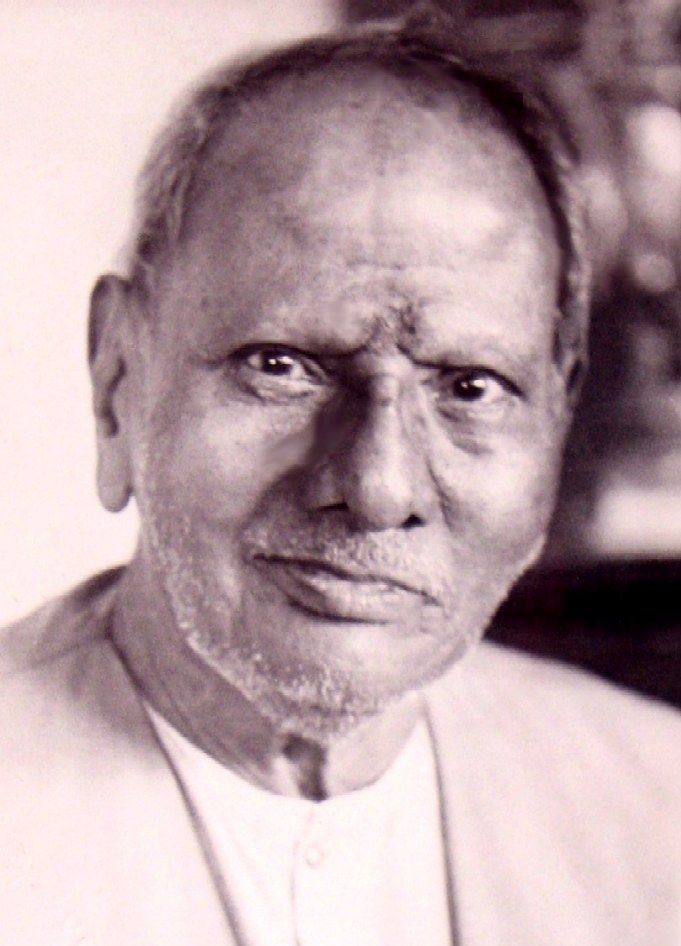
Tradition and Gurus
In 1933, he was introduced to his Guru, Siddharameshwar Maharaj, the head of the Inchagiri branch of the Navnath Sampradaya, by his friend Yashwantrao Baagkar. The mythological origins of the Inchagiri Sampradaya are ascribed to Adiguru Shri Dattatreya. He initiated the Navanaths, the Holy Nine Gurus of the Navanath Sampradaya. This makes Sri Nisargadatta one of the historical Masters of Datta/Navnath Tradition. In his own words, Sri Nisargadatta Maharaj explains the Navnath Sampradaya: ‘The Navnath Sampradaya is only a tradition, a way of teaching and practice. It does not denote a level of consciousness. If you accept a Navnath Sampradaya teacher as your Guru, you join his Sampradaya. Usually, you receive a token of his grace – a look, a touch, or a word, sometimes a vivid dream or a strong remembrance.’
His Guru told him, ‘You are not what you take yourself to be…’ Siddharameshwar initiated him into the Inchagiri Sampradaya, giving him meditation instructions and a mantra, which he immediately began to recite. Siddharameshwar gave Nisargadatta instructions for self-enquiry, which he followed blindly, as he recounted later:
‘My Guru ordered me to attend to the sense ‘I am’ and to give attention to nothing else. I just obeyed. I did not follow any particular course of breathing, or meditation, or study of scriptures. Whatever happened, I would turn away from it and remain with the sense ‘I am.’ My only reason for doing it was that my Guru told me so. It may look too simple, even crude. Yet it worked!’
Following his Guru’s instructions to concentrate on the feeling ‘I Am’, he used all His spare time looking at himself in silence and remained in that state for the coming years, practicing meditation and singing devotional bhajans:
‘My Guru told me: ‘…Go back to that state of pure being, where the ‘I am’ is still in its purity before it got contaminated with ‘I am this’ or ‘I am that.’ Your burden is of false self-identifications — abandon them all. Trust me. I tell you: you are Divine. Take it as the absolute truth. Your joy is divine. Your suffering is divine too. All come from God. Remember it always. You are God; your will alone is done.’ I did believe him and soon realised how wonderfully true and accurate his words were. I did not condition my mind by thinking, ‘I am God, I am wonderful, I am beyond.; I simply followed his instruction to focus the mind on pure being, ‘I am’, and stayed in it. I used to sit for hours together, with nothing but the ‘I am’ in my mind, and soon the peace and joy and deep all-embracing love became my normal state. In it all disappeared — myself, my Guru, the life I lived, the world around me. Only peace remained, and unfathomable silence.’ (I Am That, Dialogue 51, April 16, 1971)
After an association that lasted hardly two-and-a-half years, Siddharameshwar Maharaj passed away on September 11, 1936. In 1937, Maharaj left Mumbai and traveled across India. After eight months, he returned to his family in Mumbai. On the journey home, his state of mind changed, realising that ‘nothing was wrong anymore.’ He spent the rest of his life in Mumbai, maintaining one small shop to earn an income. Soon after His Guru died, Maruti took the name of Nisargadatta, which means the one who dwells in a natural state.
Teachings
Nisargadatta gave talks and answered questions at his humble flat in Khetwadi, Mumbai, where a mezzanine room was created for him to receive disciples and visitors. This room was also used for daily chantings, bhajans (devotional songs), meditation sessions, and discourses.
Inchagiri Sampradaya emphasised mantra meditation from its inception in the early 19th century, but that emphasis shifted toward a form of Self-enquiry with Sri Siddharameshwar. Nevertheless, Sri Nisargadatta Maharaj still gave mantra initiation, with the underlying point being that the mantra was more than sound. It was the Absolute Itself reverberating throughout life in all circumstances.
Nisargadatta adopted a different mode of instruction, through questions and answers, for his Western disciples. Many of Nisargadatta Maharaj’s talks were recorded and formed the basis of ‘I Am That’, which is the culmination and compilation of the essence of his teaching. There are other books attributed to him that are equally important and suitable for avid seekers:
- Consciousness and the Absolute
- I Am Unborn
- The Nectar of Immortality
- Self-Knowledge and Self-Realisation
- The Ultimate Medicine
from Nisargadatta’s Guru:
- Golden Day – Sri Siddha Rameshwar Maharaj
from one of Nisargadatta’s disciples Jean Dunn:
- Jean Dunn Journals: Being with Nisargadatta Maharaj 1977-1981
According to many, Nisargadatta’s only subject was:
Our real identity is the birthless-deathless, infinite-eternal Absolute Awareness or Parabrahman, and Its play of emanated, universal consciousness. For Maharaj, our only ‘problem’ (an imagined one!) is a case of mistaken identity: we presume to be an individual, and, originally and fundamentally, we are not an individual; we are intrinsically always and only the Absolute.
Nisargadatta explains:
‘The life force prana and the mind are operating of their own accord, but the mind will tempt you to believe that it is ‘you’. Therefore, always understand that you are the timeless, spaceless witness. And even if the mind tells you that you are the one who is acting, don’t believe the mind. The apparatus mind and the functioning body have come upon your original essence, but you are not that apparatus.
In ‘Consciousness and the Absolute’, Nisargadatta Maharaj further explains:
In the consciousness hierarchy, there are three stages:
- Jivatman is the one who identifies himself with the body-mind. The one who thinks I am a body, a personality, an individual apart from the world, excludes and isolates himself from the world as a separate personality because of identification with the body and the mind.
- Next is the beingness, or the consciousness, which is the world. ‘I Am’, meaning my whole world, just being, and the world. Together with the beingness, the world is also felt – that is Atman.
- The Ultimate principle that knows this beingness cannot be termed at all. It cannot be approached or conditioned by any words. That is the Ultimate state.
Self-enquiry
‘I know only Atma-yoga, which is ‘Self-Knowledge’, and nothing else. My process is Atma-yoga, which means abidance in the Self’.’ Nisargadatta was critical of a merely intellectual approach to non-dual Truth. He had a strong devotional zeal towards his Guru. He suggested the path of devotion, Bhakti yoga, to some of his visitors, as he believed the path of knowledge or Jnana yoga was not the only approach to Truth. Nisargadatta also emphasised the love of Guru and God and the practice of mantra repetition and singing bhajans, devotional songs.
Quotes from Sri Nisargadatta Maharaj
- ‘It is always the false that makes you suffer, the false desires and fears, the false values and ideas, the false relationships between people. Abandon the false, and you are free of pain; truth makes happy, truth liberates.’
- ‘Wisdom is knowing I am nothing, Love is knowing I am everything, and between the two my life moves.’
- ‘You will receive everything you need when you stop asking for what you do not need.’
- ‘Once you realise that the road is the goal and that you are always on the road, not to reach a goal, but to enjoy its beauty and its wisdom, life ceases to be a task and becomes natural and simple, in itself an ecstasy.’
- ‘Your expectation of something unique and dramatic, of some wonderful explosion, is merely hindering and delaying your Self Realisation. You are not to expect an explosion, for the explosion has already happened – at the moment when you were born when you realised yourself as Being-Knowing-Feeling. There is only one mistake you are making: you take the inner for the outer and the outer for the inner. What is in you, you take to be outside you, and what is outside, you take to be in you. The mind and feelings are external, but you take them to be intimate. You believe the world to be objective, while it is entirely a projection of your psyche. That is the basic confusion, and no new explosion will set it right! You have to think yourself out of it. There is no other way.’
- ‘A quiet mind is all you need. All else will happen rightly once your mind is quiet. As the sun rising makes the world active, so does self-awareness affect changes in the mind. In the light of calm and steady self-awareness, inner energies wake up and work miracles without any effort on your part.’
- ‘All you want is to be happy. All your desires, whatever they may be, are longing for happiness. Basically, you wish yourself well…desire by itself is not wrong. It is life itself, the urge to grow in knowledge and experience. It is choices you make that are wrong. To imagine that some little thing – food, sex, power, fame – will make you happy is to deceive yourself. Only something as vast and deep as your real self can make you truly and lastingly happy.’
- ‘Don’t try to understand! It’s enough if you do not misunderstand.’
- ‘The consciousness in you and the consciousness in me, apparently are two but in reality one, seek that unity; that is love.’
- ‘Love is not selective; desire is selective. In love, there are no strangers. When the center of selfishness is no longer, all desires for pleasure and fear of pain cease; one is no longer interested in being happy; beyond happiness, there is pure intensity, inexhaustible energy, the ecstasy of giving from a perennial source.’
- ‘The mind creates the abyss; the heart crosses it.’
- ‘Nothing ever goes wrong.’ (Tidak ada satu pun yang berjalan keliru)

Sacred Practices/Sadhana
Nisargadatta taught what has been called Nisarga Yoga (Nisarga can be translated as ‘nature’). In ‘I Am That’, Nisarga Yoga is defined as living life with ‘harmlessness’, ‘friendliness’, and ‘interest’, abiding in ‘spontaneous awareness’ while being ‘conscious of effortless living’. This form of Yoga practice involves meditating on one’s sense of ‘I am’, ‘being’, or ‘consciousness’, to reach its ultimate source before this sense, which Nisargadatta called the ‘Self’.
Nisargadatta did not prescribe a specific practice for self-knowledge but advised his disciples, ‘Don’t pretend to be what you are not, don’t refuse to be what you are.’ Using self-enquiry in the tradition of Advaita Vedanta, he advised, ‘Why don’t you enquire how real are the world and the person?’ Nisargadatta frequently spoke about the importance of having the ‘inner conviction’ about one’s true nature, and that without such Self-knowledge, one would continue to suffer. Nisargadatta claimed that the names of the Hindu deities Shiva, Rama, and Krishna were the names of nature (Nisarga) personified and that all of life arises from the same non-dual source or Self.
Remembrance of this source was the core of Nisargadatta’s message:
‘You are not your body, but you are the consciousness in the body, because of which you have an awareness of ‘I am.’ It is without words, just pure beingness. It has become the soul of the world. In the absence of your consciousness, the world will not be experienced. Hence, you are the consciousness… remember what you have heard… meditate on it. Meditation means you have to hold consciousness by itself. The consciousness should give attention to itself. This consciousness is Ishwara. As there is no God other than this consciousness, worship it.’ ‘The knowledge ‘I am’ is God. It is Ishwara, as well as Maya. Maya is God’s power. All the names of God are of this consciousness only in different forms. Remember the fact ‘I am not the body’ and get firmly established. That is the sign of a true seeker.’
The Seven Principles of Nisarga Yoga:
- Non-identification and right understanding
- Interest and earnestness
- Spontaneity and effortlessness
- Attentiveness to being
- Right action
- Going within to go beyond
- Awareness of Self
Contemporary Masters
Among his best-known disciples are Maurice Frydman, Sailor Bob Adamson, Stephen Howard Wolinsky (born 31 January 1950), Jean Dunn, Alexander Smit (Sri Parabrahmadatta Maharaj) (1948-1998), Douwe Tiemersma (7 January 1945 – 3 January 2013), Robert Powell, Timothy Conway, Wayne Dyer and Ramesh Balsekar (1917-2009).
A less well-known disciple is Sri Ramakant Maharaj (born 8 July 1941), who received the Naam mantra from Nisargadatta in 1962, spent the next 19 years with the Master, and claims to be ‘the only Indian direct disciple of Sri Nisargadatta Maharaj’ who offers initiation into this lineage. Sachin Kshirsagar, who has published a series of books on Nisargadatta in the Marathi language and re-published Master of Self Realisation, says he received the Naam (Mantra) in a dream from Sri Nisargadatta Maharaj on 17 Oct. 2011.
Holy Sites and Pilgrimages
- Apartment in Mumbai where Sri Nisargadatta lived: Vamali Bhavana, Second Floor, Khetwadi 10th Lane, near Grant Road.
- Sri Nisargadatta Maharaj was cremated at Baganga grounds in Mumbai where the Samadhi of Maharaj’s Guru, Sri Sidharamshwar Maharaj, is also located.
- The physical form of the Master merged into the elements of which it was made. Saying anything further about the Master would be both superfluous and inadequate, and wholly against Maharaj’s teaching.
Bibliography
- I AM THAT – Talks with Sri Nisargadatta Maharaj
- Consciousness and the Absolute by Jean Dunn
- I Am Unborn by Pradeep Apte
- The Nectar of Immortality by Robert Powell
- Self-Knowledge and Self-Realisation by Jean Dunn
- The Ultimate Medicine by Robert Powell
- Pointers of Nisargadatta Maharaj by Ramesh S. Balsekar
External Links
- I AM THAT – By Nisargadatta Maharaj
- nisargadatta.net
- www.maharajnisargadatta.com a Resource website
- www.nisargadatta.co.uk The essential message/teachings of Sri Nisargadatta Maharaj


